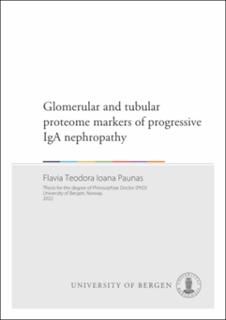Glomerular and tubular proteome markers of progressive IgA nephropathy
Doctoral thesis

Åpne
Permanent lenke
https://hdl.handle.net/11250/2996654Utgivelsesdato
2022-06-03Metadata
Vis full innførselSamlinger
Sammendrag
Background: IgA nephropathy (IgAN) is the most common glomerulonephritis in the world, with a clinical course ranging from asymptomatic non-progressive to aggressive and progressive disease to kidney failure. The exact mechanism of progression is not fully understood and further research is needed. Proteomics could help to investigate the mechanism of progression in IgAN and define potential biomarkers.
The aims of this study were:
-To identify novel tissue biomarkers for progressive IgAN that may be used for prognostication.
-To improve understanding of underlying mechanisms in IgAN.
-To separately investigate glomerular and tubular biomarkers in IgAN.
Methods: Formalin-fixed paraffin-embedded kidney biopsy of patients with IgAN and control from the Norwegian Kidney Biopsy Registry were used. The IgAN group was divided in progressive or non-progressive based on progression to kidney failure over 10 years. Glomerular and tubulointerstitial tissues were microdissected, the proteome was analysed using mass spectrometry and the protein abundance was compared between groups.
Results: As compared to IgAN patients without progressive disease, glomeruli from patients with progressive IgAN had significantly higher abundance of components of the classical and the terminal complement pathways (Paper I), and the tubulointerstitial tissue had higher abundance of proteins related to inflammation (Paper III). As compared to controls, glomeruli from patients with IgAN showed significantly higher abundance of extracellular matrix structural proteins and extracellular matrix associated proteins (Paper II). Periostin was the protein with the highest fold change between groups both in glomeruli and tubuli.
Conclusions: Microdissection of glomeruli and tubuli allowed for compartment-specific analyses of prognostic markers and a better understanding of underlying mechanisms of progressive IgAN. The most promising marker seem to be periostin which associated with progressive disease both in glomeruli and tubuli.
Består av
Paper I: Paunas FTI, Finne K, Leh S, Marti HP, Mollnes TE, Berven F, Vikse BE: Glomerular abundance of complement proteins characterized by proteomic analysis of lasercaptured microdissected glomeruli associates with progressive disease in IgA nephropathy. Clin Proteomics 2017;14:30. The article is available at: https://hdl.handle.net/1956/17588Paper II: Paunas FTI, Finne K, Leh S, Osman TA, Marti HP, Berven F, Vikse BE. Characterization of glomerular extracellular matrix in IgA nephropathy by proteomic analysis of lasercaptured microdissected glomeruli. BMC Nephrol. 2019;20:410. The article is available at: https://hdl.handle.net/1956/22502
Paper III: Paunas FTI, Finne K, Leh S, Marti HP, Berven F, Vikse BE: Proteomic signature of tubulointerstitial tissue predicts prognosis in IgAN. BMC Nephrol. 2022;23:118. The article is available at: https://hdl.handle.net/11250/2996651
